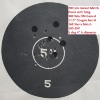D.B. Cooper
Member
- Joined
- Oct 2, 2016
- Messages
- 4,396
To crimp or not to crimp.
I'm a bout to start loading up a few different loads for my M1 Garand for service rifle. We had a discussion about this several months ago, but this was one thing that didn't come up.
I'll be loading 150 grn and 168 grn projectiles to be loaded single shot from an open bolt. (200 and 600 yrds respectively.) And 150 grn projectiles for the 300 yrd rapid fire strings.
My thought is I'll get better accuracy from an uncrimped cartridge. However, do I need to crimp to make sure the cartridges are reliable and don't come part under recoil? Should I be crimping everything, or just the ones I load into en block clips for the rapid fire?
I'm a bout to start loading up a few different loads for my M1 Garand for service rifle. We had a discussion about this several months ago, but this was one thing that didn't come up.
I'll be loading 150 grn and 168 grn projectiles to be loaded single shot from an open bolt. (200 and 600 yrds respectively.) And 150 grn projectiles for the 300 yrd rapid fire strings.
My thought is I'll get better accuracy from an uncrimped cartridge. However, do I need to crimp to make sure the cartridges are reliable and don't come part under recoil? Should I be crimping everything, or just the ones I load into en block clips for the rapid fire?
























